Papers by Dr. Nikolaos Pellas

Research and Practice in Technology Enhanced Learning , 2025
Students' perspectives on using generative artificial intelligence (AI) chatbots and machine lear... more Students' perspectives on using generative artificial intelligence (AI) chatbots and machine learning are crucial in shaping the design, development, and implementation of their learning projects across various disciplines. Cognitive thinking, a key aspect of AI-related machine learning, aims to replicate human intelligence and behavior. However, the relation between cognitive thinking and knowledge acquisition is often overlooked. This cross-sectional study empirically examines the relationship between academic achievement and students' attitudes toward machine learning, particularly through the use of generative AI chatbots. It specifically focuses on the role of higher-order thinking skills-such as problemsolving, critical thinking, and creativity-as both mediators and moderators in this relationship. A total of four hundred sixteen undergraduate students (n=416) from diverse academic backgrounds voluntarily took part in a project, in which they designed and developed generative AI chatbots in media and information literacy courses. The findings indicate that creativity mediated the relationship between academic achievements and attitudes toward machine learning, but its moderating impact was not significant. Problem-solving and critical thinking did not show significant mediating effects on attitudes toward machine learning, while they showed significant moderating effects in the connection between academic performance and attitudes toward machine learning. This study contributes by elucidating the interrelationships between students' higher-order thinking skills, academic performance, and attitudes on the use of AI and machine learning technologies. By highlighting the mediating role of creativity and the moderating effects of problem-solving and critical thinking, this study offers a deeper understanding of how these skills shape students' perceptions of AI.

Education and Information Technologies., 2024
Teacher professional development (TPD) programs face several challenges in fostering active parti... more Teacher professional development (TPD) programs face several challenges in fostering active participation and ensuring high-quality learning experiences compared to traditional approaches. While online TPD programs offer flexibility, concerns remain about their effectiveness in promoting high-quality content and autonomous learning. This study aims to address these concerns by comparing the effectiveness of Massive Open Online Courses (MOOCs) and Learning Management Systems (LMS) in enhancing teacher autonomy and perceptions of TPD program quality. A cross-sectional study was conducted to examine how these platforms influence teachers' perceptions of key TPD quality indicators, including clarity, structure, cognitive stimulation, collaboration, and practical relevance, as well as the development of their autonomous learning. The current study also explores how individual teacher characteristics such as certification level, experience, and gender, might influence these effects. A total of 108 teachers (n=108) participated in TPD programs delivered through either MOOCs (12 courses) or LMS (14 courses). The results indicate that while both platforms received positive evaluations, MOOCs exhibited slightly higher overall ratings for quality indicators. Additionally, participants enrolled in MOOCs reported significantly greater autonomous learning development compared to those using LMS. Moreover, higher certification and experience levels were associated with more positive perceptions of TPD quality across both platforms. This study contributes to the field by highlighting the potential for both MOOCs and LMS to support high-quality TPD, which can foster teacher autonomy, while also emphasizing the importance of considering individual teacher characteristics in TPD program design.
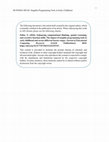
Journal of Educational Computing Research, 2024
Tangible programming tools (TPTs) are promising teaching aids in programming courses due to their... more Tangible programming tools (TPTs) are promising teaching aids in programming courses due to their interactivity and ability to enhance early childhood students' computational thinking, spatial reasoning, and executive function skills. However, it remains unclear whether TPTs support these skills simultaneously. This study examines the impact of TPTs on enhancing cognitive thinking skills among students at different developmental stages, with a focus on early childhood education. A quasi-experimental study with pre-and post-tests was conducted involving 82 preschoolers aged 5-7. Participants were categorized into three developmental stages (beginner, intermediate, advanced) based on their prior programming experience. A TPT called "Bee-bot Brushing Challenge: A Computational Adventure" was employed during a STEM summer camp program. The findings revealed significant improvements in students' abstract thinking, problem decomposition, and spatial reasoning skills, particularly among beginners. Participants at intermediate levels showed notable improvement in algorithm design and efficiency. Results also indicate significant differences in cognitive flexibility and inhibitory control between groups, with advanced students outperforming beginners and intermediates while working memory remained unaffected. This research provides important evidence supporting the inclusion of TPTs in early childhood curricula to foster comprehensive cognitive development. It offers valuable insights for educators and policymakers in designing similar learning environments.

Multimodal Technologies and Interaction, 2024
Digital platforms are increasingly prevalent among young students in K-12 education, offering sig... more Digital platforms are increasingly prevalent among young students in K-12 education, offering significant opportunities but also raising concerns about their effects on self-assessment and academic performance. This study investigates the effectiveness of Kahoot! compared to traditional instructional methods in enhancing mathematics achievement and its impact on multiple screen addiction (MSA) among Greek students aged 9 to 12 during a STEM summer camp. A quasi-experimental design was employed with a purposefully selected sample of one hundred and ten (n = 110) students, who were non-randomly divided into two groups: (a) an experimental group of fifty-five students (n = 55) who engaged with Kahoot! (using dynamic visual aids and interactive content) and (b) a control group of fifty-five students (n = 55) who received traditional instruction (using digital textbooks and PowerPoint slides with multimedia content) on laptops and tablets. The findings revealed a statistically significant difference in MSA scores, with the experimental group exhibiting lower MSA scores compared to their counterparts, indicating a positive impact on reducing screen addiction levels. While Kahoot! led to lower MSA levels, it significantly improved overall mathematical achievement, with a substantial effect size, suggesting a strong positive impact on learning outcomes. The current study highlights the importance of aligning educational tools with the intended outcomes and recommends further research to explore the broader impact of gamified learning on student engagement, screen addiction, and learning outcomes.
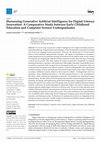
AI, 2024
The recent surge of generative artificial intelligence (AI) in higher education presents a fascin... more The recent surge of generative artificial intelligence (AI) in higher education presents a fascinating landscape of opportunities and challenges. AI has the potential to personalize education and create more engaging learning experiences. However, the effectiveness of AI interventions relies on well-considered implementation strategies. The impact of AI platforms in education is largely determined by the particular learning environment and the distinct needs of each student. Consequently, investigating the attitudes of future educators towards this technology is becoming a critical area of research. This study explores the impact of generative AI platforms on students’ learning performance, experience, and satisfaction within higher education. It specifically focuses on students’ experiences with varying levels of technological proficiency. A comparative study was conducted with two groups from different academic contexts undergoing the same experimental condition to design, develop, and implement instructional design projects using various AI platforms to produce multimedia content tailored to their respective subjects. Undergraduates from two disciplines—Early Childhood Education (n = 32) and Computer Science (n = 34)—participated in this study, which examined the integration of generative AI platforms into educational content implementation. Results indicate that both groups demonstrated similar learning performance in designing, developing, and implementing instructional design projects. Regarding user experience, the general outcomes were similar across both groups; however, Early Childhood Education students rated the usefulness of AI multimedia platforms significantly higher. Conversely, Computer Science students reported a slightly higher comfort level with these tools. In terms of overall satisfaction, Early Childhood Education students expressed greater satisfaction with AI software than their counterparts, acknowledging its importance for their future careers. This study contributes to the understanding of how AI platforms affect students from diverse backgrounds, bridging a gap in the knowledge of user experience and learning outcomes. Furthermore, by exploring best practices for integrating AI into educational contexts, it provides valuable insights for educators and scholars seeking to optimize the potential of AI to enhance educational outcomes.
Journal of Research on Technology in Education , 2024
Integrating web-based platforms into student learning assessment has gained increasing attention ... more Integrating web-based platforms into student learning assessment has gained increasing attention among researchers and instructors. However, limited research addresses the practical challenges of involving undergraduates in the creation of web-based assessment platforms. This study investigates the effects of this process on students’ learning outcomes and their psycho-emotional experiences, focusing on motivation and engagement. A comparative study involving 156 students revealed that those using Kahoot! platform achieved significantly better learning outcomes and displayed higher motivation and emotional engagement than those using Google Forms. It also highlights the role of interface design in improving web-based assessment platforms, with implications for user interface design.
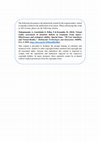
Multimodal Technologies and Interaction, 2024
Early detection is crucial for addressing attention deficits commonly associated with Traumatic b... more Early detection is crucial for addressing attention deficits commonly associated with Traumatic brain injury (TBI), informing effective rehabilitation planning and intervention. While traditional neuropsychological assessments have been conventionally used to evaluate attention deficits, their limited ecological validity presents notable challenges. This study explores the efficacy and validity of a novel virtual reality test, the Computerized Battery for the Assessment of Attention Disorders (CBAAD), among a cohort of TBI survivors (n = 20), in comparison to a healthy control group (n = 20). Participants, ranging in age from 21 to 62 years, were administered a comprehensive neuropsychological assessment, including the CBAAD and the Attention Related Cognitive Errors Scale. While variations in attentional performance were observed across age cohorts, the study found no statistically significant age-related effects within either group. The CBAAD demonstrated sensitivity to attentional dysfunction in the TBI group, establishing its value as a comprehensive test battery for assessing attention in this specific population. Regression analyses demonstrated the CBAAD’s effectiveness in predicting real-life attentional errors reported by TBI patients. In summary, the CBAAD demonstrates sensitivity to attentional dysfunction in TBI patients and the ability to predict real-world attentional errors, establishing its value as a comprehensive test battery for assessing attention in this specific population. Its implementation holds promise for enhancing the early identification of attentional impairments and facilitating tailored rehabilitation strategies for TBI patients.
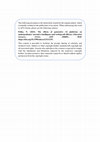
Education Sciences, 2023
Digital storytelling and generative Artificial Intelligence (AI) platforms have emerged as trans-... more Digital storytelling and generative Artificial Intelligence (AI) platforms have emerged as trans-formative tools that empower individuals to write with confidence and share their stories effec-tively. However, a research gap exists in understanding the effects of using such web-based platforms on narrative intelligence and writing self-efficacy. This study aims to investigate whether digital story creation tasks on web-based platforms can influence the narrative intelli-gence and writing self-efficacy of undergraduate students. A pretest-posttest comparison study between two groups was conducted with sixty-four undergraduate students (n=64), majoring in Primary education. More specifically, it compares the effects of the most well-known conventional platforms, such as Storybird, Storyjumper, and ZooBurst (control condition), and generative AI platforms, such as Sudowrite, Jasper, and Shortly AI (experimental condition) on undergraduate students, with an equal distribution in each group. The findings indicate that the utilization of generative AI platforms in the context of story creation tasks can substantially enhance both narrative intelligence scores and writing self-efficacy when compared to conventional platforms. Nonetheless, there was no significant difference in the creative-identity-writing factor. Generative AI platforms have promising implications for supporting undergraduates' narrative and writing self-efficacy in fostering their story creation design and development.
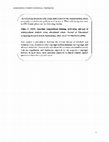
Journal of Educational Computing Research , 2023
Educational technologists and practitioners have made substantial strides in developing affordabl... more Educational technologists and practitioners have made substantial strides in developing affordable digital and tangible resources to support both formal and informal computer science instruction. However, there is a lack of research on practice-based assignments, such as Internet of Things (IoT) projects, that allow undergraduate students to design and demonstrate educational robots using digital or physical assistance, especially when it comes to computational thinking (CT) and programming skills development in association with their psycho-emotional experience. This study compares the impact of Scratch and LEGO® WeDo robotic kits on students' CT and programming skills development. A quasi-experimental approach was conducted, involving two hundred forty-six participants (n=246), who were equally divided between Scratch and LEGO® WeDo groups. Results indicate that the LEGO® WeDo group showed greater improvement in CT and programming skills development while designing and presenting IoT projects. Nevertheless, no significant association between motivation, grit, and CT skills was observed. The findings highlight the potential of tangible robotics in facilitating students’ hands-on learning and enhancing motivation to foster CT and programming skills. This study provides a wide range of implications for instructional designers on how to use tangible robotics to support hands-on IoT projects in computer science courses.
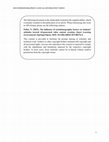
Smart Learning Environments, 2023
Artificial Intelligence (AI) and Machine Learning (ML) technologies offer the potential to suppor... more Artificial Intelligence (AI) and Machine Learning (ML) technologies offer the potential to support digital content creation and media production, providing opportunities for individuals from diverse sociodemographic backgrounds to engage in creative activities and enhance their multimedia video content. However, less attention has been paid to recent research exploring any possible relationships between AI-generated video creation and the sociodemographic variables of undergraduate students. This study aims to investigate the multifaceted relationship between AI-generated video content and sociodemographics by examining its implications for inclusivity, equity, and representation in the digital media landscape. An empirical study about the use of AI in video content creation was conducted with a diverse cohort of three hundred ninety-eighth undergraduate (n=398) students. Participants voluntarily took part and were tasked with conceiving and crafting their AI-generated video content. All instruments used were combined into a single web-based self-report questionnaire that was delivered to all participants via email. Key research findings demonstrate that students have a favorable disposition when it comes to incorporating AI-supported learning tasks. The factors fostering this favorable attitude among students include their age, the number of devices they use, the time they dedicate to utilizing technological resources, and their level of experience. Nevertheless, it is the student’s participation in AI training courses that exerts a direct impact on students’ ML attitudes, along with their level of contentment with the reliability of these technologies. This study contributes to a more comprehensive understanding of the transformative power of AI in video content creation and underscores the importance of considering instructional contexts and policies to ensure a fair and equitable digital media platform for students from diverse sociodemographic backgrounds.
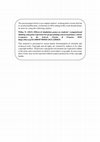
Computers in the Schools, 2023
There is substantial evidence that incorporating interactive environments for game-based instruct... more There is substantial evidence that incorporating interactive environments for game-based instruction has a significant potential to support the development of computational thinking and programming skills in primary education students. However, it is not clear whether a simulation game (SG) with different user interface elements, created via three-dimensional (3D) virtual worlds and visual programming environments to project various problem-solving exercises in a simulated reality, can significantly influence students to think and practice "computationally" their solution plans into code. The current study aims to identify any possible added value of each instructional approach by measuring students' game experience and learning performance. This quasi-experimental study involved ninety participants (n=90) aged between 10 and 11 years that consisted of two comparison conditions. The experimental group (n=45) received training using OpenSimulator in combination with Scratch4SL, whereas the control group (n=45) was solely trained using Scratch. The findings indicate considerable differences in students' game experience and satisfaction, but no statistically significant difference in their learning performance and knowledge gain was identified. This study provides several design implications for user interface and game elements to inform educational practitioners and instructors about the benefits that each approach can offer students for better knowledge acquisition and deeper disciplinary understanding.

Journal of Computer Assisted Learning, 2023
Background: Owing to the exponential growth of three-dimensional (3D) environments among research... more Background: Owing to the exponential growth of three-dimensional (3D) environments among researchers and educators to create simulation games (SGs) in primary education, there is a growing interest to examine their potential support in computer science courses instead of visual programming environments. Objectives: This study explores the relationships between students’ learning performance, focusing on computational thinking (CT) and programming skills development, in association with their cognitive load (mental load and mental effort) and emotions (happiness, anger, anxiety, sadness) by playing a SG. Methods: A total of two-hundred and ninety participants (n=290) in fifth-grade classes (10-11 years old) of Greek primary schools completed all pre-and post-intervention tests. A quasi-experimental study was conducted over a 14-week timetable course and in two comparison conditions, in which a SG was created by using OpenSimulator&Scratch4SL and Scratch for the experimental group (n=145) and the control group (n=145), respectively. To further investigate the effectiveness of the proposed SG in each teaching intervention, an exploration of relationships between students’ learning performance, cognitive load, and emotions through multiple analyses, depending on correlation, t-tests, correlation, and hierarchal regression were delivered. Results and Conclusions: The findings indicate that the proposed SG created by using OpenSimulator&Scratch4SL positively affected students’ emotions and cognitive load, whereas there was no significant difference in learning gain between the two groups. Implications: This study provides empirical evidence on the effects of SGs on students’ knowledge acquisition, highlighting the importance of considering both cognitive and emotional components in the design of these games. The findings offer valuable insights for implications and design guidelines.
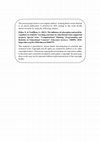
Education Sciences, 2023
The field of educational technology has made significant strides, offering cost-effective multime... more The field of educational technology has made significant strides, offering cost-effective multimedia tools and physical resources to facilitate both formal and informal teaching methods in computer science, with a particular emphasis on the development of computational thinking (CT)
and programming skills. However, there is a lack of research focusing on practice-based tasks, such as Internet of Things (IoT) projects, for undergraduate students to demonstrate and program educational
robots using digital and physical-supported instructional approaches. Specifically, there have been no studies examining the association between students’ learning outcomes and their absorption and need for cognition on different platforms, such as Scratch and LEGO® WeDo. This
study aims to provide empirical evidence by comparing the impact of two different platforms commonly used in programming courses to teach undergraduate students how to design, develop, and program IoT projects using educational robots. A quasi-experimental study was carried out to examine whether there were any significant variations in students’ CT skills and programming development, as well as to evaluate their learning outcomes with regard to their need for cognition and absorption when they applied their coding expertise to real-world IoT projects. As a point of reference (control condition), twenty students (n = 20) utilized LEGO® WeDo robotics kits and Scratch for coding tasks, which is the most familiar instructional approach. In the intervention approach
(experimental condition), thirty-seven students (n = 37) used LEGO® WeDo robotics kits and their software to learn how to code their educational robots. Participants from the laer group learned
how to design and demonstrate the program and showed superior CT skills and programming skills development than their counterparts in the control group who used Scratch. Furthermore, the results indicate that students with higher levels of CT skills and programming execution reveal lower absorption but a higher need for cognition in educational robot-supported IoT projects.

Education and Information Technologies, 2021
While there is an increasing interest in Augmented Reality (AR) technologies in Primary and Secon... more While there is an increasing interest in Augmented Reality (AR) technologies in Primary and Secondary (K-12) Education, its application in Higher Education (HE) is still an emerging trend. This study reports findings from a systematic mapping review, based on a total of forty-five (n = 45) articles published in international peer-reviewed journals from 2010 to 2020, after evaluating the use of AR applications that support Science, Technology, Engineering and Mathematics (STEM) subjects’ learning in HE settings. This review’s results highlighted the lack of research across the STEM spectrum, especially in the Technology and Mathematics subfields, as well as the scarcity of location-based and markerless AR applications. Furthermore, three augmentation techniques, suitable for STEM learning, were identified and analysed: augmentation of laboratory specialised equipment, physical objects and course handbooks or sheets. The main contribution of this article is a taxonomy of instructional models and the discussion of applied instructional strategies and techniques in STEM fields focused on HE settings. In addition, we provide visualisations of the present state of the area, which aim at encouraging and scaffolding educators’ efforts based on specific classification criteria to develop AR experiences and conduct further research to enhance STEM learning.
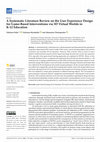
Multimodal Technologies and Interaction, 2021
A substantial body of literature has well-documented and demonstrated the potential of using thre... more A substantial body of literature has well-documented and demonstrated the potential of using three-dimensional (3D) virtual worlds (VWs) across various learning subjects and contexts in primary and secondary (K-12) education. However, little is known when it comes to issues related to child-interaction research and the impact that design decisions have on the user experience (UX), especially when game-based learning approaches are employed in 3DVWs. Hence, in this systematic literature review, we appraise and summarize the most relevant research articles (n = 30) conducted in K-12 settings, published between 2006–2020 and that elicit information related to (a) the interaction design (ID) of game events and trends associated with game elements and features that were utilized for the development and creation of game prototypes, (b) the research methods which were followed to empirically evaluate their teaching interventions, and (c) the design-related issues and factors affecting ID a...

Η παιδαγωγική αξιοποίηση τρισδιάστατων πολυχρηστικών εικονικών κόσμων ανοιχτού κώδικα, όπως αυτός... more Η παιδαγωγική αξιοποίηση τρισδιάστατων πολυχρηστικών εικονικών κόσμων ανοιχτού κώδικα, όπως αυτός του Open Sim σε συνδυασμό με δυσδιάστατα προγραμματιστικά περιβάλλοντα, όπως αυτό του Scratch4OS για την εισαγωγή των μαθητών σε βασικές αλγοριθμικές δομές, θεωρείται ένα ενδιαφέρον θέμα προς διερεύνηση. Σκοπός της δική μας μελέτης περίπτωσης ήταν η αξιοποίηση και αξιολόγηση των δύο αυτών περιβαλλόντων από 27 μαθητές της Α΄ Λυκείου, ως μια εναλλακτική πλατφόρμα υλοποίησης διδακτικών σχεδίων εργασίας προγραμματισμού δομών ακολουθίας μέσα από το μοντέλο της διερευνητικής μάθησης. Η προστιθέμενη αξία της εργασίας αυτής προτίθεται να φέρει στο προσκήνιο τις θετικές στάσεις και απόψεις των εκπαιδευομένων χρηστών για θεμελιώδη ζητήματα που άπτονται της συνεργασίας, της επικοινωνίας τους με τον καθηγητή ή τους άλλους συμμαθητές, αλλά και την ευκολία προσαρμογής τους σε ένα καινοτόμο πολυχρηστικό περιβάλλον δράσης και μάθησης κατά τη διάρκεια εμπλοκής τους. Οι παράγοντες αυτοί θεωρούνται ιδιαίτ...
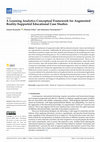
Multimodal Technologies and Interaction, 2021
The deployment of augmented reality (AR) has attracted educators’ interest and introduced new opp... more The deployment of augmented reality (AR) has attracted educators’ interest and introduced new opportunities in education. Additionally, the advancement of artificial intelligence has enabled educational researchers to apply innovative methods and techniques for the monitoring and evaluation of the teaching and learning process. The so-called learning analytics (LA) discipline emerged with the promise to revolutionize traditional instructional practices by introducing systematic and multidimensional ways to improve the effectiveness of the instructional process. However, the implementation of LA methods is usually associated with web-based platforms, which offer direct access to learners’ data with minimal effort or adjustments. On the other hand, the complex nature of immersive technologies and the diverse instructional approaches which are utilized in different scientific domains have limited the opportunities for research and development in this direction. Within these research co...
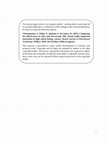
British Journal of Educational Technology, 2023
The promise of using immersive technologies in learning has increasingly been attracting research... more The promise of using immersive technologies in learning has increasingly been attracting researchers’ and practitioners’ attention. However, relevant empirical works are usually conducted in fully controlled Virtual Reality (VR) laboratories, as opposed to conventional settings. This quasi-experimental study compares the effectiveness of video learning resources to that of stereoscopic 360o VR, as supplements to the traditional instructional approach. The potential of such methods was examined in high school settings, in the context of the ‘Life and Evolution’ module, with participants (n=70) divided equally into control and experimental groups. As a point of reference (control condition), we considered the adoption of Video Learning Resources, as students are more acquainted with this instructional method. In the intervention approach (experimental condition), students adopted the use of low-end mobile-VR (VeeR Mini VR Goggles). The key findings indicate differences in the learning motivation, confidence, and satisfaction, but no statistically significant difference was identified regarding the factual or conceptual knowledge gains. The study offers insights on the potential of the investigated technologies in the subject of secondary school Biology and further provides implications for theory and practice.
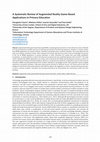
Augmented Reality game-based learning (ARGBL) is quickly gaining momentum in the education sector... more Augmented Reality game-based learning (ARGBL) is quickly gaining momentum in the education sector worldwide as it has the potential to enable new forms of learning and transform the learning experience. However, it remains unclear how ARGBL applications can impact students' motivation and performance in primary education. This study addresses that topic by providing a systematic review, which analyses and critically appraises the current state of knowledge and practice in the use of ARGBL applications in primary education. In total, seventeen (17) studies that used either qualitative, quantitative, or mixed-methods to collect their data were analysed and were published between 2012 and 2017. The study results indicated that ARGBL applications are mainly used to document the design and development process, as well as to share preliminary findings and student feedback. Based on a comprehensive taxonomy of application areas for AR in primary education, ARGBL can potentially influence the students' attendance, knowledge transfer, skill acquisition, hands-on digital experience, and positive attitudes in laboratory experimental exercises for different courses. This review aims to offer new insights to researchers and provide educators with effective advice and suggestions on how to improve learning outcomes, as well as increase students' motivation and learning performance by incorporating this instructional model into their teaching.
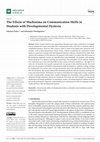
Education Sciences
Many research efforts in the international literature have been conducted to investigate various ... more Many research efforts in the international literature have been conducted to investigate various fundamental issues associated with communication skills cultivation of students with developmental dyslexia. However, little is known when it comes to the impact that ‘immersive technologies’, such as three-dimensional virtual worlds, without considering any exploration of their impact to assist boys and girls with developmental dyslexia cultivate communication skills. Motivated by this inadequacy in the literature, the purpose of this study is to explore the effectiveness of the machinima approach, created via OpenSimulator and Scratch4SL, for students with developmental dyslexia in vocabulary learning and practicing. This embedded mixed-methods research was conducted over a four-week timetable in-class course, with forty students (n = 40) aged 10–12 years old. All students were equally separated into two groups in line with their gender. Boys and girls were encouraged to unfold the com...










Uploads
Papers by Dr. Nikolaos Pellas
and programming skills. However, there is a lack of research focusing on practice-based tasks, such as Internet of Things (IoT) projects, for undergraduate students to demonstrate and program educational
robots using digital and physical-supported instructional approaches. Specifically, there have been no studies examining the association between students’ learning outcomes and their absorption and need for cognition on different platforms, such as Scratch and LEGO® WeDo. This
study aims to provide empirical evidence by comparing the impact of two different platforms commonly used in programming courses to teach undergraduate students how to design, develop, and program IoT projects using educational robots. A quasi-experimental study was carried out to examine whether there were any significant variations in students’ CT skills and programming development, as well as to evaluate their learning outcomes with regard to their need for cognition and absorption when they applied their coding expertise to real-world IoT projects. As a point of reference (control condition), twenty students (n = 20) utilized LEGO® WeDo robotics kits and Scratch for coding tasks, which is the most familiar instructional approach. In the intervention approach
(experimental condition), thirty-seven students (n = 37) used LEGO® WeDo robotics kits and their software to learn how to code their educational robots. Participants from the laer group learned
how to design and demonstrate the program and showed superior CT skills and programming skills development than their counterparts in the control group who used Scratch. Furthermore, the results indicate that students with higher levels of CT skills and programming execution reveal lower absorption but a higher need for cognition in educational robot-supported IoT projects.
and programming skills. However, there is a lack of research focusing on practice-based tasks, such as Internet of Things (IoT) projects, for undergraduate students to demonstrate and program educational
robots using digital and physical-supported instructional approaches. Specifically, there have been no studies examining the association between students’ learning outcomes and their absorption and need for cognition on different platforms, such as Scratch and LEGO® WeDo. This
study aims to provide empirical evidence by comparing the impact of two different platforms commonly used in programming courses to teach undergraduate students how to design, develop, and program IoT projects using educational robots. A quasi-experimental study was carried out to examine whether there were any significant variations in students’ CT skills and programming development, as well as to evaluate their learning outcomes with regard to their need for cognition and absorption when they applied their coding expertise to real-world IoT projects. As a point of reference (control condition), twenty students (n = 20) utilized LEGO® WeDo robotics kits and Scratch for coding tasks, which is the most familiar instructional approach. In the intervention approach
(experimental condition), thirty-seven students (n = 37) used LEGO® WeDo robotics kits and their software to learn how to code their educational robots. Participants from the laer group learned
how to design and demonstrate the program and showed superior CT skills and programming skills development than their counterparts in the control group who used Scratch. Furthermore, the results indicate that students with higher levels of CT skills and programming execution reveal lower absorption but a higher need for cognition in educational robot-supported IoT projects.